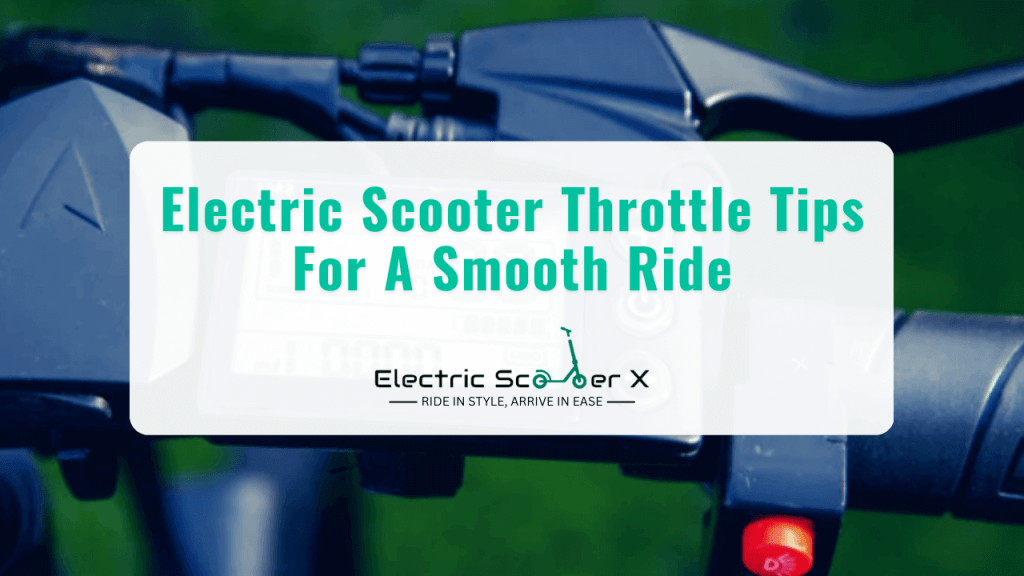The Basics of Electric Scooter Throttles
Throttles are components that you use to accelerate and control the speed of a vehicle. And it is as crucial as any other necessary equipment for an electric scooter. In this article, we will provide an overview of the basics of an electric scooter throttle. The functionality, ergonomics, and other essential information.
Table Of Contents
ToggleThe throttle on an electric scooter is simple enough. Turning the throttle on sends electrical signals that get the scooter running. As simple as it is, its functionality is critical to that scooter. It regulates the speed and acceleration of your vehicle. Without it, your scooter is just good-looking furniture sitting in your garage.
Throttle Functionality
Throttles on the electric scooter work by sending an electrical signal to the scooter’s motor controller. That signal changes the motor’s power output to meet the desired speed. Simply put, the more you push/ squeeze the throttle, the faster it goes, and vice versa.
Electric scooter brands also come with a brake lever, which does the opposite of the throttle. Sends signal to the motor controller to slow down safely. This sort of brake is known as an electrical or regenerative brake. These breaks extend the life of the actual brake pads. To know more about electric scooter breaks, visit our article here.
Different styles, Different Throttles
Mostly there are two common types of electric scooter throttles. The Thumb and twist throttle are the two. But there are other sorts of throttles that are used. We will go with the 4 most common types. The thumb, twist, trigger/finger & the wheel throttle. We will also discuss their pros and cons –
Thumb Throttle: As the name suggests you use your thumb to accelerate, Thumb throttles are usually situated in the right handlebar and controlled by the rider’s thumb. You push the lever to accelerate and pull away to slow down. Thumb throttles are the most frequently used type of throttle on electric scooters since they are easy to use and intuitive for most riders.
Pros
- Linear and intuitive controls
- One hand operation
- Easy to use.
- Ergonomic design. Requires minimal effort to operate.
- Compact module.
- Cheaper than other throttles
Cons
- Less precise than other ones
- Limited hand positions
- Limited compatibility with other scooters
- Plug-And-Play might not be available
- Chances of accidental triggers
Twist Throttle: Twisters are throttles that you see on a motorcycle. You twist it back to accelerate and maintain the speed. It’s the most common after the thumb throttle. But better at regulating the speed with precision.
Pros
- Precise controls
- Similar design to motorcycles
- Can be used with multiple fingers
- Easy speed control
Cons
- Requires more effort to operate
- Hand fatigue over extended use
- Less intuitive for beginners
- Can be accidentally triggered
Trigger/Finger Throttle: Trigger throttles are becoming increasingly popular among High electric scooter riders. Trigger throttles are usually found on high-performance electric scooters. Day by day newer models are adapting triggers and throttles. They are a bit modular. LCD
Pros
- Precise controls
- Only the Index finger is required
- Can be operated with multiple fingers
- Easy speed modulation
Cons
- Less intuitive for beginners
- Hand fatigue after extended use
- More effort may be needed to operate
- Limited compatibility with some electric scooters.
Wheel Throttle
Pros
- Precise control
- Easy to use with thumb or palm
- Can be used with multiple fingers
- Easy to modulate speed
Cons
- Less intuitive for beginners
- Hand fatigue over extended use
- Requires more effort to operate
- Limited compatibility with some electric scooters.
As time goes on and you’re a daily user of your trusty electric scooter, there may come a time when you’re throttle is no longer in its best form. Wear & Tear is the common reason. Over time, the wiring and the electrical components can become worn out. And that may cause a malfunction. Throttles can also receive damage due to overuse, moisture, and impact. In that case, the best option is to replace your throttle with a new one.
Models with traditional cabling might need professional expertise. But most electric scooters nowadays tend to have plug-and-play cabling. They provide quick and easy installation, and it requires little to no experience. You can easily replace your current one with your desired type of throttle.
Compared to traditional connectors, plug-and-play offers a more secure connection, lowering the possibility of loose connections or wiring mishaps. It is extremely important to make sure a replacement throttle has plug-and-play connectors that work with the scooter’s wiring system before making a purchase.
Electric Scooter Throttle’s Price
Prices aren’t that high when it comes to throttles. People usually go with Thumb or twist throttles for replacements. Thumb throttles are known to be a cheaper alternative, costing measly about $10-$20. On the other hand, higher-quality throttles come with features like LCDs, built-in speedometers, and cruise control. They cost upwards of $50-$100. So yeah, prices may vary on the brand, quality, and type.
It is an important reminder to always check the manufacturer’s specifications as well as voltage compatibility before buying.
How to Buy Replacement Electric Scooter Throttles
The best place to start is by checking with the scooter’s manufacturer. Many scooter manufacturers sell replacement parts. The notable manufacturers include-
- Xiaomi
- Razor
- Ninebot
- Swagtron
- Segway
Replacements from the source have it’s benefits, you get the authentic product and they can provide you with the exact part number and specs. One major downside may be the price. On the other hand, let’s say your scooter manufacturer doesn’t sell replacement throttles. Or maybe you’re looking for a cheaper option, In that case, many third-party sellers might offer what you’re looking for. Just carefully read the specifications to confirm that the throttle is suitable for your bike.


